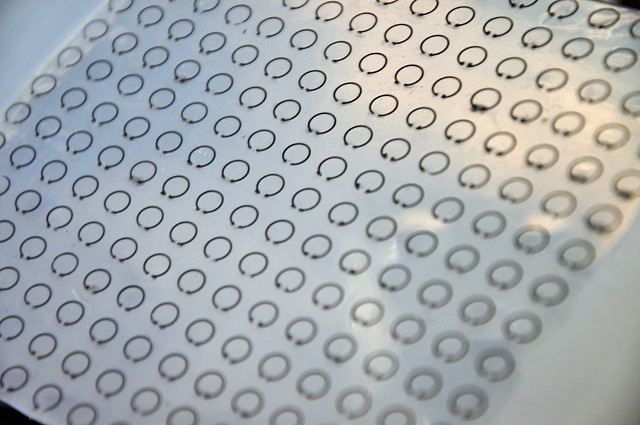Mar 8 2016
Engineers at Iowa State University have created a flexible meta-skin that is capable of shielding objects from powerful radar waves. This stretchable and tunable meta-skin utilizes a row of tiny liquid-metal devices to trap and suppress the radar waves at a specific frequency, and shields objects against the sharp radar waves.
 This flexible, stretchable and tunable "meta-skin" can trap radar waves and cloak objects from detection. (Credit: Liang Dong)
This flexible, stretchable and tunable "meta-skin" can trap radar waves and cloak objects from detection. (Credit: Liang Dong)
This new meta-skin polymer is named after metamaterials, which are composites with unique properties that are not seen in nature, and are capable of controlling electromagnetic waves. The polymer can be stretched, flexed, and adjusted to decrease the reflection of a different range of radar frequencies. The study has been reported in the journal, Scientific Reports.
Associate professor Liang Dong and professor Jiming Song are lead authors from Iowa State’s department of electrical and computer engineering. Co-authors include Iowa State graduate students Qiugu Wang, Peng Liu, Siming Yang, and former Iowa State undergraduate Mingda Yang.
The engineers wrote; “It is believed that the present meta-skin technology will find many applications in electromagnetic frequency tuning, shielding and scattering suppression,”
Dong has experience in creating micro and nano scale devices, and handling polymers and liquids. Song’s expertise lie in finding new applications in the field of electromagnetic waves. Both are working to establish the idea that tunable and flexible liquid metal technologies can be used to suppress electromagnetic waves, and possibly even the shorter wavelengths of visible light. The team came up with the idea of using rows of split ring electric resonators filled with galinstan and integrated in silicon sheet layers. Galinstan is a metal alloy, which remains liquid at room temperature, and is comparatively less toxic than other liquid metals like mercury.
The resonators are tiny rings with a thickness measuring 0.5 mm, an outer radius measuring 2.5 mm and a gap measuring 1 mm, which produces a small and curved section of liquid wire. The rings and the gap create electric inductors and electric capacitors respectively. They collectively produced a resonator circuit that is capable of trapping and suppressing the radar waves at a particular frequency. By stretching the meta-skin, the integrated liquid metal rings are changed, which changes the frequency suppressed by the devices.
According to the report, test results demonstrated that about 75% of the radar frequencies were suppressed between the 8 and 10 GHz range. When objects were cloaked in the meta-skin, suppression of radar waves occurred in all observation angles and incident directions.
“Therefore, this meta-skin technology is different from traditional stealth technologies that often only reduce the backscattering, i.e., the power reflected back to a probing radar,” the engineers wrote in their article.
While describing the technology Song showed a picture of B-2 stealth bomber, he hopes that someday the meta-skin would be used to coat the surface of an advanced stealth aircraft. The researchers are aspiring for even more, like an invisible cloak.
The long-term goal is to shrink the size of these devices. Then hopefully we can do this with higher-frequency electromagnetic waves such as visible or infrared light. While that would require advanced nanomanufacturing technologies and appropriate structural modifications, we think this study proves the concept of frequency tuning and broadening, and multidirectional wave suppression with skin-type metamaterials.
Liang Dong, Associate Professor, Iowa State University
The project was partly supported by the China Scholarship Council and the National Science Foundation.